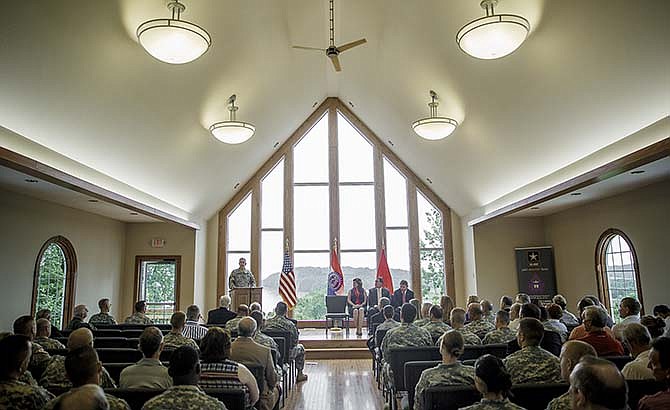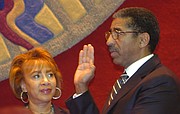The Chapel windows overlook the Missouri River and - in the distance - Clark's Hill, where the Lewis and Clark Expedition camped in June 1804, near the beginning of their 2½-year journey to the Pacific Ocean and back.
However, the Missouri National Guard's new Resiliency Center is intended to allow modern soldiers and their families to explore a different kind of frontier - their mental health.
"This was a culmination of a number of things," Missouri Adjutant Gen. Stephen L. Danner said after the Saturday dedication ceremony and ribbon cutting. "My own service in Iraq - I did 18 months tour total - and I realized what everyone goes through, once you've been there and done that.
"I think it changes your mindset."
Col. Gary Gilmore, the Army National Guard's senior chaplain, told a crowd of approximately 100 Guard members and supporters at Saturday's ceremonies, "Today is a banner day, as we mark the culmination of a project that reflects our organization's commitment to the well-being of soldiers and airmen, their family members and our veteran community."
He noted the building's front includes "the symbolic pillars of resilience - social, emotional, spiritual, financial, family and physical. These pillars combine our strength and character to make us resilient.
"Resilience is our inner fortitude and strength to face life's challenges, to learn how to grow through adversity."
Danner reminded the audience the National Guard had to plan and build the chapel and its center on their own, with the help of donations, because he was told there were "no funds for that," even though similar facilities are available to the active-duty military.
That's why he worked with others to form the Missouri National Guard Foundation, which "worked hard to raise funds (so we could) do this ourselves."
Scott Englund, who served overseas with Danner and retired from the Guard as a major, is the foundation board's president.
"The vision was to establish this chapel and its Resiliency Center to promote the health, security, happiness and well-being of Missouri National Guard members, veterans and their families," Englund said, "by fostering counseling and other programs that support those pillars of resiliency that Chaplain Gilmore spoke of."
He added the center would not have been possible without the money donated by a number of groups, including Veterans United, Central Bank, Worldwide Technologies, Bob Scruggs of Scruggs Lumber and many others.
One of the key supporters was Ameren Missouri, whose vice president for external affairs and communications, Warren Wood, said his company "has been, and will continue to be, a staunch supporter of our military."
The company got involved in the Resiliency Center project because "it's our duty to to give back to those who serve," Wood said. "Freedom isn't free."
While the building itself is beautiful, Wood added, "It's not so much about what's on the outside, but about all the caring and healing that will take place inside these walls."
It was Danner's initial vision that made the project happened, according to Wood, Englund, Gilmore and others.
Danner noted in his remarks, and later in his interview, that his first months as the state National Guard's commander included a number of funeral services for members killed in action.
"We were losing a soldier about once every three weeks," he recalled.
"It was tough for me to do proper services on a drill floor or in our auditorium," he recalled - but the non-denominational chapel can provide a more appropriate setting.
Also, that need was what he called his "direct inspiration." However, he added another need was also great.
"We've got, literally, thousands of Missouri Guardsmen - and we not only serve the Missouri Guard, but we also serve any of the service members who come to us for assistance," he said. "PTSD is real. Traumatic Brain Disorder is real.
"Those are things that we need to address, not only from the mental - but the physical - aspects, but also the effect that it has on the families of service members.
"So, this facility will assist not only those service members with their difficulties, but also the collateral difficulties that families face when a service member has traumatic stress syndrome."
He acknowledged veterans of previous wars and conflicts didn't have the kind of support he expects the center will provide.
However, things have changed in society and in the military - especially after 14 years of involvement in the Middle East wars.
"I think medical science has advanced that much more," he explained. "I know that the medical advances - and, quite frankly, the media spotlight on it - has helped tremendously in bringing this to the fore, when it might have been swept under the rug, again.
"But now, we really try to pay attention to the medical piece of traumatic stress syndrome and it's the collateral effects on the family."
Resiliency Center construction uncovered 1850's burial site
Construction of the Missouri National Guard's new Resiliency Center stretched over nearly five years.
However, construction also was slowed when some graves were found on the same site, at the northeast end of the Ike Skelton Training Center, on a bluff overlooking the Missouri River.
"The burial site that we knew was up here was from about the 1850s, of local settlers - we even have their names," Adjutant Gen. Stephen L. Danner explained. "We went through the Department of Natural Resources and through the courts, in the process (used) when you find human remains."
The area between the chapel and the river remains contains several small, marker flags where other graves might be, and some of the bodies found already have been re-buried with volunteered assistance from the Houser-Millard Funeral Service, Danner said.
"Eventually, in honor of those past settlers, we will have a picket fence and a little gravesite behind the chapel - and a plaque where they are buried - to recognize them," he said.


